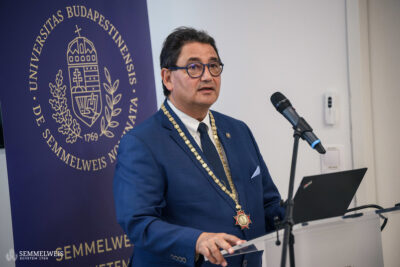From 9 to 11 October in Budapest, the 6th Congress of the South-East European Society of Neurological Surgery (SeENS) was jointly organised. The Hungarian Society of Neurosurgery (MIT) XXV. Congress. This large-scale event was attended by more than 300 participants from 25 countries, who were able to listen to nearly 180 presentations. Many lecturers and researchers from Semmelweis University also made presentations, and university staff played a crucial role in the conference organizing committee. The main aim of the event was to enable world-renowned researchers to present their latest scientific results in Hungary, promote cooperation and professional relations between local and international researchers, and involve foreign researchers and doctoral students in the work of local scientific workshops.

VI of the South-Eastern European Neurosurgical Society (SeENS). The Hungarian Society of Neurosurgery (MIT) XXV. Congress I'm staying at the Insana Thermal Hotel on Margate Island. The conference was organized by Dr. It was opened by Peter Banczerowski, Head of the Department of Neurosurgery at Semmelweis University. In his greeting, he stressed the importance of joint organization that enhances international cooperation, and stressed that the event provides an opportunity for participants to exchange their knowledge, learn from each other, and promote the development of neurosurgery. Dr. Peter Banczerowski received Dr. Torsten R. Melingit, President of the European Association of Neurosurgical Societies (EANS), and Dr. Tomislav Sajkot, who also gave a short speech.
The sponsor of the ceremony is Dr. Tamás Freund was president of the Hungarian Academy of Sciences. The conference was chaired by Dr. Peter Banczerowski, Head of the Department of Neurosurgery at Semmelweis University and Dr. It was held by Tomislav Saiko, President of the South-Eastern European Society of Neurosurgery. Dr. Ihsan Solaroglu, Professor of the Department of Neurosurgery, Koc University, Istanbul, and Dr. Laszlo Nowak, President of the Hungarian Neurosurgical Society, was co-chair of the Scientific Committee. Dr. Lorand Eros, Director of the Department of Neurosurgery and Neurointervention at Semmelweis University and Dr. László Sipos, Chief Physician of the Department of Craniofacial and Vascular Neurosurgery, served as Chairman of the Local Organizing Committee.
 Dr. Bella Merkle, Dean of Semmelweis University, spoke at the opening ceremony held on the evening of October 9 about the importance of joint scientific work, and the role of cooperation in developing science, as well as educating youth and society. Entry of young people into international scientific life. The conference provides an excellent opportunity for all of these, and it also creates an opportunity for world-renowned researchers in the field to present their latest scientific results in Hungary. He stressed that strengthening international professional cooperation can not only have a stimulating effect on Hungarian scientific life, but also help in the development of neurosurgery as a whole.
Dr. Bella Merkle, Dean of Semmelweis University, spoke at the opening ceremony held on the evening of October 9 about the importance of joint scientific work, and the role of cooperation in developing science, as well as educating youth and society. Entry of young people into international scientific life. The conference provides an excellent opportunity for all of these, and it also creates an opportunity for world-renowned researchers in the field to present their latest scientific results in Hungary. He stressed that strengthening international professional cooperation can not only have a stimulating effect on Hungarian scientific life, but also help in the development of neurosurgery as a whole.
Everyone here knows that medicine and health sciences are among the fastest developing disciplines in the world, with the volume of knowledge doubling every year or two. Neuroscience is considered one of the most innovative of these sciences
Dr. highlighted. Bella Merkle. He added that the leading local institution in this field, the National Institute of Neuropsychology and Neurosurgery (OMIII) of North America, and the Neurology, Neurointerventional and Neurosurgery Services, joined Semmelweis University in March this year, with the emergence of the Neurosurgery and Neurointervention Clinic. Neurological, greater emphasis is placed on specialization in the curriculum.
See the sixth. and MIT XXV. His conference lectures focused on several important areas from a neurosurgical point of view: spine, pituitary, neuro-oncology, vascular system, trauma, skull base, neuroradiology, peripheral nervous system, pediatric neurosurgery and radiosurgery; Nurses also had separate departments. In addition to thematic sections, plenary and keynote presentations, thematic corporate seminars and poster presentations also enriched the programme. In general, the different presentations took place in three parallel sessions. Particular emphasis was placed on showcasing the latest research and clinical innovations, as well as the professional engagement of young researchers and doctoral students, for whom special sessions, workshops and poster presentations were organised. This gave them the opportunity to present their own research, exchange experiences with international colleagues, and participate in the life of the scientific community.
the Hungarian Society of Neurosurgery MIT was founded in 1966 with the aim of developing Hungarian neurosurgery, expanding the professional and scientific knowledge of its members, promoting their continuing education, and providing them with medical ethics education. MIT's mission includes disseminating the results of Hungarian research as widely as possible, both at home and abroad. Over the years, MIT has gained significant national and international recognition. the South East European Society of Neurosurgery (SeENS) is a non-profit professional organization founded in 2012 with the aim of stimulating cooperation and exchange of expertise between neurosurgeons in the region, and thus improving neurosurgical care, training and research in South-Eastern Europe. The joint organization of the conference comes as a result of the strong professional relations and close cooperation between the two organizations.
Dr. Balazs Cizmadia
Photo: Balint Barta – Semmelweis University
The article was published by the Communications Directorate of Semmelweis University.






